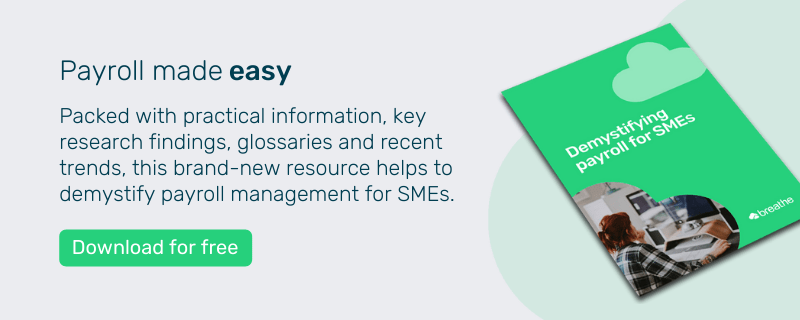There’s no doubt that PAYE and payroll management is one of the most important aspects of business administration. Paying employees accurately and on time is essential for your employee’s wellbeing and home life – they need to be able to rely on being paid on a consistent basis and without delays.
Pay your employees incorrectly or late and you’ll start to see problems creeping in. Employees may suffer from short-term cash flow problems, be unable to pay bills and may even suffer with weak credit scores as a result.
And that impacts you as an employer.
After all, who wants to work for someone who pays their employees unreliably? Paying employees inconsistently can damage employee morale, negatively impact a company’s reputation and damage your ability to recruit and retain team members.
In this article we explain what PAYE is and look at the basic rules by which businesses must manage this aspect of employment.
Skip to:
Real Time Information (RTI) Reporting
What are PAYE reporting forms?
What is PAYE (UK)?
Pay as you earn – frequently abbreviated to PAYE – was first introduced in 1944. It's the system by which UK employers deduct income tax and National Insurance contributions from an employee wages, before paying their salary or pension.
Employees have a tax code which is calculated by HMRC. This determines how much an employer deducts from someone’s gross pay. The amount someone is paid after deductions have been made is called net pay.
All money collected from deductions is sent to HMRC by the employer ‘at source’. This means directly from employees’ wages before it reaches their bank account. National Insurance and student loan repayments may also be deducted in this way.
If you’re already involved in managing PAYE, there is a high chance you are using one of the many payroll software systems which automate payment and deduction calculations. There are also tools produced by HMRC itself which automate some of the more basic calculations. Some of these tools are freely available from HMRC’s website.
Is PAYE the same as payroll?
PAYE is the HMRC system to collect income tax and national insurance. Most employers have to operate PAYE within their payroll processes.
Tax & business location
Wherever a company is based in the UK, directors must understand their tax position. Historically, all tax policy was governed entirely by central government in London. But as Wales and Scotland gained their devolved powers, this is no longer the case. They now have the opportunity to set income tax rates that best suit their local populations.
The information in this article applies to PAYE rules which apply to businesses registered in England, Wales and Northern Ireland.
What is payroll management?
Payroll management refers to the records, processes, information and deductions (e.g. taxes) that relate to payroll.
Working with tax codes
Salary and wage deductions are worked out using each employee’s tax code and National Insurance category letter.
To do this, you input an employee’s tax code into your payroll software or HMRC system. This will calculate how much tax you need to deduct from their pay throughout the year.
If you are taking on a new employee, you would normally work out their tax code by using the employee’s P45. The code will usually be made up of several numbers and a letter, such as 1257L - the most common tax code and one which applies to many employees.
Read our quick-reference factsheet to debunk the most commonly-used tax codes.
Updating for the new tax year
HMRC will tell you about any new tax codes to use for employees in the new tax year (starting on 6 April) between January and March. Once you have this information, you should update payroll records as soon as possible.
If an employee’s tax code isn’t changing, HMRC won’t contact you. In this case you carry the employee’s existing tax code forward to the new tax year.

Compulsory PAYE deductions
So, what Income Tax and National Insurance deductions does a business to make? The government provides very clear guidance on this matter and provides a definitive list which is updated as and when PAYE legislation is amended. The list of compulsory deductions is published on the Gov.UK website.
Summary of deductions
-
Employee Income Tax deductions
-
Class 1 and 1B National Insurance
-
Class 1A National Insurance on termination awards and sporting testimonials
-
Student Loan repayments
-
Construction Industry Scheme (CIS) deductions
-
Apprenticeship Levy payments
-
Student and postgraduate loan repayments
-
Compulsory child maintenance deductions
Real Time Information (RTI) Reporting
Until relatively recently, employers were obliged to file detailed reports of all deductions at the end of the financial year to HMRC. However, this changed in 2013 with the introduction of Real Time Information (RTI) reporting. This means that it is now compulsory for employers to report their payroll calculations throughout the year and provide these to HMRC online. This makes the process much quicker and more efficient. If you outsource your payroll, the company which provides the service will submit the reports.
What are PAYE reporting forms?
These are the forms which are used to provide employees about their gross and net pay, including tax, NI and other types of deductions and payments made to HMRC during a financial year. The main forms are:
Payslips
You should provide all employees with payslips each payday. These should show gross and net pay as well as tax and NI deductions. Payslips should also include information about all other deductions, for example, student loan repayments and pension contributions.
P60
The P60 form is an End of Year Certificate. It shows an employee’s total earnings from jobs or pensions in the tax year that has just ended. It also shows how much tax they have paid. If your employee is working on 5th April of any year, then you need to provide then with a P60 form by 31st May each year.
Employees need P60s to claim back overpaid tax and apply for tax credits.
P11D
The P11D form is used to report the benefits in kind that an employee has received during the financial year. These are items or services that you have given an employee in addition to their salary. These include private healthcare, interest-free loans (to pay for season train tickets for example) and company cars.
P45
New employees need to provide you with their P45 when they first join you. This enables you to register the employee and take on the management of their salary and deductions. The P45 is comprised of two parts; one for you and a second part for the employee and their records.
Key facts:
-
Employers are required to issue a P45 to all team members who leave their employment.
-
This form includes an employee’s name, their tax office and reference number alongside the tax code used to calculate tax deductions.
-
The P45 also shows when an employee was last paid, the gross pay they have received in the tax year before joining their new employer.
P45 form vs ‘starter checklist’
If your new employee arrives without a P45 you will need the employee to complete a starter checklist (formerly a P46 form) and enter the information into your payroll system. If your payroll software doesn’t generate the necessary checklist then you can find the starter checklist on the Government’s website.
Employees and pensions
Under the Pensions Act 2008, every employer in the UK must put their eligible staff into a workplace pension and pay into that pension.
No matter how long your company or organisation has been running for, you have automatic enrolment duties to comply with when you take on your first worker. These duties apply from your new employee’s first day of employment - this is known as a business’ duties start date.
Financial year-end reporting
Once upon a time (before 2013), payroll administrators and managers would dread annual year-end reporting. It was incredibly time-consuming and complex, especially if payroll calculations were completed manually or compiled in spreadsheets. These were notoriously prone to errors and reporting PAYE information for even a relatively small numbers of employees was a thoroughly onerous task.
However, by spreading reporting responsibilities throughout the financial year, RTI has benefitted payroll administrators and managers by eliminating the pressure and burden of manual year-end calculations and form submissions.
Small business payroll management
In 1789, Benjamin Franklin famously wrote:
“Our new Constitution is now established, everything seems to promise it will be durable; but, in this world, nothing is certain except death and taxes.”
More than two centuries on, and this quote is as accurate now as it was when it was written and tax management is an important area which cause serious problems for businesses if is not managed properly.
Small business payroll management is a specialist area of administration in its own right which can look daunting to the initiated, but modern payroll software has been designed to take care of much of the heavy lifting in terms of calculating payments and deductions.
HMRC provides comprehensive advice and support and there are also many accountants and financial services who can help those who are new to the subject.
Our demystifying payroll report can help SMEs get up to speed with what they need to know about payroll.

Author: Laura Sands
Laura is a writer who enjoys getting into the detail of subjects and sharing that knowledge with snappy, interesting content. When not typing away, she enjoys walks in the woods and curling up with a good book and mug of something hot.


.webp)

